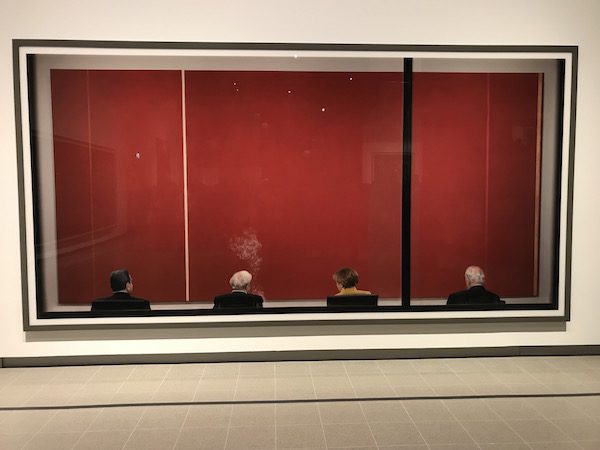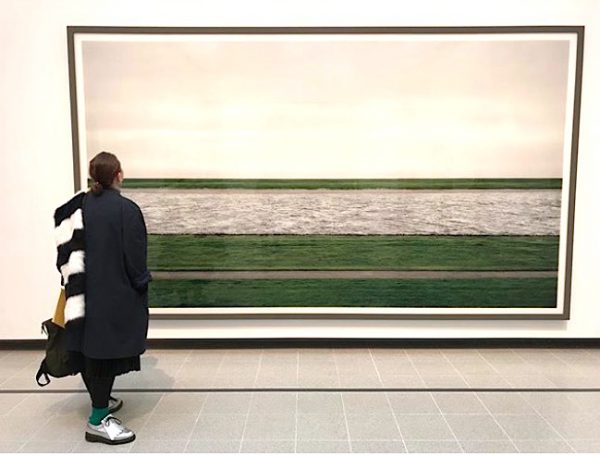For those of us who remember the state of the Hayward Gallery before the just completed rehab, the current Andreas Gursky show, which celebrates its re-opening, is a very pleasant surprise. The upstairs space now has what amounts to a completely new roof, with excellent top lighting, and the hang of Gursky’s photographs, many of enormous size, is notably spacious and well considered. One recalls the ‘installationist’ clutter of the Hayward shows that immediately preceded the rehab and heaves a sigh of relief.
Gursky’s work owes much to the tradition of Modernist abstraction – ELS
The choice of exhibition marks subtle sea-change has overtaken the official British art world during the time when the restructuring of the gallery building was taken place. Installation exhibitions have by no means vanished, but they aren’t the hot ticket they once were, and the Gursky show is notably free of the simplistic political messages and general air of smug, know-it-all do-goodery that have typified some recent exhibitions held in official spaces here in London.

Though, judging from the programme of exhibitions announced for the spaces during the coming year, it may be struggling to make a come-back. What fascinated me about the Gursky show was what it had to say about the revolution that has overtaken photography as an art form.
The most obvious of these changes is in terms of scale. It is only very recently that we have come to accept that ‘art’ photography can be very big – a huge public statement. Commercial photography, for posters and billboards, got there long ago. The change in scale has in large part been due to a technological shift, from analogue, or partly analogue, to purely digital.
It has also sprung from a sharp rise in the actual prestige of the photograph. Photographic images are no longer the little sisters of image making, lacking as they are in the resonant history that clings to other forms of pictorial image-making. The camera can’t look back proudly to the achievements of Michelangelo. Or of Titian. Or, for that matter, to those of Palaeolithic man, busily at work in his cave. There is a break, in theory (though not always in practice) from the proud tradition of the hand-made.
Other changes, as evinced in Gursky’s photographs, are subtler. The images, as the catalogue of the exhibition stresses, are very many presentations of the real world – the world that the spectator can perceive with his own eyes. Yet, the more closely you look, the more you become aware that they owe much to the tradition of Modernist abstraction. That is, to the very aspects of Modernist art that deliberately eschewed representation. Which, in fact, sought to divorce themselves from the supposed banality of the ‘real world’. Creating, instead of a totally independent visual existence, which seems to offer the very opposite of the things that photography is, within its own brief tradition, supposedly about.
A huge image of tulip fields, for instance, presents itself as a series of horizontal bands of colour, modelled on a template familiar from many examples of Modernist abstract painting. You have to look very closely indeed to become aware that the photograph does, in fact, represent something – that it is not independent of a situation that actually exists. This is also true of an image that shows the Formula I race-track in Bahrein – from which the cars themselves are conspicuously absent.

Sometimes Gursky allows himself a touch of irony – a grandiose snow-scape, in the midst of which some minuscule skiers are gawkily struggling, like so many ants. Very often, he edits drastically – an image of the river Rhine, a horizontal bank flowing smoothly across the picture-surface, from which all vestiges of an industrial complex of the far bank have been completely removed.
There are other, more complex edits of this kind. Photographs of things, complex, highly detailed representations of the industrial or commercial worlds, that have been smoothly pieced together from multiple images, so as to remove any trace of the camera’s essentially monocular vision.
This is linked to the fact that Gursky’s instincts seem very often to be the absolute contrary of what one expects of vision wedded to the camera. Dramatic, arbitrary crops – the essence of much contemporary photography – are largely absent from his work. And he draws back, rather than trying to come close in.
One very recent image, present in the Hayward show and (tellingly) used for the cover of the book that accompanies it, indicates that Gursky is intent on trying to move further on. Called simply Utah, and dated 2017, it shows a panoramic landscape, photographed from the window of a moving train. The basic picture was made using a mobile phone, and the whole foreground is blurred as a result.
There is a double message here, I think. First, the image accepts the passage of time, any sense of which is absent from the other pictures in the exhibition. Second, it indicates that Gursky recognises that his chosen art form, photography, is undergoing yet another stage of the democratic revolution which has always been part of its history.
In the age of the mobile phone, making photographic images has become such a normal element of human dialogue that we have quite forgotten what it might be like to be without them. Making them just as much or even more than looking at them. Self-conscious artiness doesn’t count anymore. Gursky sidles up to the Kardashians, and offers them a big hello!
Words: Edward Lucie-Smith Photos: Sara Faith © Artlyst 2018

